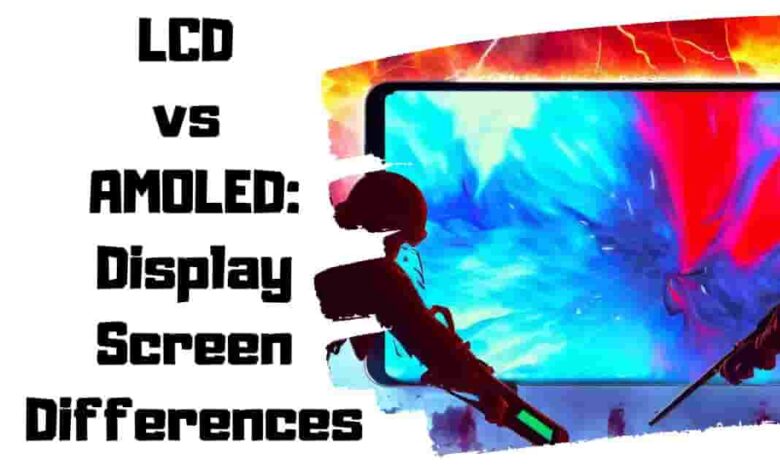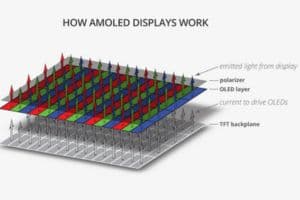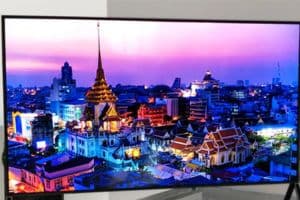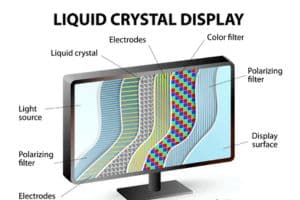LCD vs AMOLED: Display Screen Differences

In the ever-evolving world of technology, the battle for screen supremacy is as heated as a clash of titans. As you claim your rightful place among the tech-savvy elite, understanding the nuances between LCD and AMOLED displays will give you invaluable knowledge that may tip the scales. Dive into this comprehensive guide and unravel the intricate details of LCD vs AMOLED display technologies. You’ll learn about their unique advantages, drawbacks, image quality comparisons, and which devices commonly sport these screen types.
With this newfound mastery at your fingertips, you’ll be well-equipped to make informed decisions when choosing the perfect Display for your gadgets or advising fellow enthusiasts on their quest for screen perfection.
So forge ahead, intrepid explorer – let us illuminate your path toward conquering the realm of display screens!
Contents
- 1 What is an AMOLED Display?
- 2 Benefits of Using an AMOLED Display Solutions
- 3 Cons of Using AMOLED Displays
- 4 AMOLED Displays Versus LCD or OLED?
- 5 Which Devices Commonly use AMOLED Displays?
- 6 What is LCD Display?
- 7 Advantages of LCD Screens over other Display Technologies?
- 8 Disadvantages of LCD Displays
- 9 LCD Displays vs. Other Display Technologies: Image Quality
- 10 What Impacts LCD Display Lifespan?
- 11 Frequently Asked Questions
- 12 Conclusion:
What is an AMOLED Display?
You might be wondering what exactly an AMOLED display is and how it differentiates itself from other screen technologies.
AMOLED stands for Active-Matrix Organic Light-Emitting Diodes, which use organic materials to create light when an electric current is applied.
The ‘active matrix’ part refers to the thin-film transistors (TFTs) that control each pixel on the screen, allowing for precise manipulation of colors and brightness levels. This technology enables AMOLED displays to produce vibrant colors, deep blacks, and excellent contrast ratios compared to traditional LCD screens.

As a result, you’ll enjoy a more immersive viewing experience with richer hues and sharper details on devices equipped with AMOLED screens. These displays provide stunning visuals and consume less power in certain scenarios – such as when displaying darker images – contributing to improved battery life in your electronic gadgets.
So next time you’re shopping for a new device or simply admiring your smartphone’s beautiful Display, remember that behind those dazzling colors lies the impressive innovation of AMOLED technology.
Benefits of Using an AMOLED Display Solutions
No wonder folks prefer devices with AMOLED displays, given their numerous advantages like vibrant colors and energy efficiency.
For instance, Samsung’s Galaxy series smartphones showcase stunning visuals while maintaining long battery life, thanks to the advanced AMOLED technology.
- These screens offer deeper blacks, vivid colors, and faster response times than display technologies like LCDs.
- The wider viewing angles of an AMOLED display ensure that you can enjoy stable image quality from almost any perspective – up to approximately 170 degrees!
- Moreover, the flexible nature of this technology opens doors for innovative gadgets with curved or folding screens that provide a truly immersive experience for users.
Ultimately, by opting for devices with an AMOLED display, you’re enhancing your visual experience and contributing to a more power-efficient future in electronics.
Cons of Using AMOLED Displays
Despite their dazzling visuals, AMOLED displays do come with a few drawbacks. These include higher costs and potential screen burn-ins, which may give some users pause before diving into this vibrant world.
Higher costs: Due to their complex mechanics, manufacturing AMOLED screens can be more expensive than other display technologies. This could translate into pricier devices for you, so considering if the added expense is worth it, those vibrant visuals are worth it.
Not color-critical friendly: If your work depends on accurate color reproduction (graphic design or photography), AMOLED displays might not be your best choice. The high saturation levels and potential for less-than-accurate colors could impact your creative endeavors.
Screen wear and burn-ins: Over time, the quality of an AMOLED display can deteriorate as pixels age and wear down. You may even experience screen burn-in – where static images or colors remain visible even when they’re off – which can be particularly annoying when displaying high contrast ratios or black background elements.
Keep these points in mind as you weigh your options, but also consider the stunning color harmony and efficiency that AMOLED displays offer. Ultimately, it’s all about finding that perfect balance between performance and preference!
AMOLED Displays Versus LCD or OLED?
When it comes to breathtaking visuals and immersive experiences, there’s simply no contest between AMOLED displays and their counterparts, like LCD or OLED. As you explore the world of screen types, you’ll discover that AMOLED display technology outshines its competitors in several key areas:
Image Quality
- AMOLED vs LCD: With higher contrast ratios and a wider color gamut, AMOLED screens deliver more vivid images than their LCD counterparts. This leads to a richer visual experience where dark blacks coexist with vibrant colors, making images come alive.
- AMOLED vs OLED: While both are based on organic materials that emit light when stimulated by electric current, AMOLED offers more precise control over individual pixels for better color accuracy and detail reproduction.
Power Consumption
- AMOLED vs LCD: Unlike LCD, which requires backlighting and consumes more energy, self-emitting organic polymers in AMOLED screens make them inherently more energy-efficient. This benefits the environment and extends your device’s battery life.
- AMOLED vs OLED Technology: Both technologies boast lower power consumption than traditional screen types; however, AMOLED typically consumes even less power due to its ability to turn off individual pixels when displaying black.
As you continue your quest for mastery in display technology, rest assured that choosing an AMOLED display will reward you with stunning visuals without compromising power efficiency.
Which Devices Commonly use AMOLED Displays?
From smartphones to laptops and even televisions, a whole array of gadgets boasting AMOLED technology’s vivid colors and energy efficiency! The battle between LCD and AMOLED display technologies rages on, with the latter gaining significant ground in recent years.
You’ll find AMOLED screens on various devices, from high-end smartphones to tablets, smartwatches, handheld game consoles, digital cameras, and computer monitors.
As one of the most common display technologies available today, it’s no surprise that mobile devices manufacturers are increasingly adopting this type of Display for their products.
With its low power consumption, excellent color reproduction, deep blacks, and impressive resolutions across different screen sizes – all at an ever-decreasing cost – it seems like the tides may favor AMOLED displays.
They continue to dominate the market for consumer electronics while providing users with an immersive visual experience that keeps them returning for more.
What is LCD Display?
It’s truly remarkable how LCD technology has revolutionized our daily lives, bringing us incredibly crisp images and energy efficiency across a wide range of devices.

An LCD display is a marvel of engineering that utilizes liquid crystal layers sandwiched between two glass panels to control the light entering and leaving each pixel on the screen. This results in an unparalleled image quality that we’ve come to expect from modern electronic devices.
To help you better understand the process, here are 4 key components that work together in an LCD display:
- Liquid Crystal Layer: The heart of the Display is made up of tiny cells filled with liquid crystals that can change their orientation when subjected to an electric field.
- Backlight: Behind the liquid crystal layer lies a backlight, which emits a consistent source of light that illuminates all pixels evenly.
- Color Filter: To add vibrant colors to your screen, there’s a color filter placed just above the liquid crystal layer, containing subpixels for red, green, and blue (RGB).
- Pixels are the minor units on your screen responsible for displaying images or text by controlling how much light passes through each cell.
These components work harmoniously within an LCD display to bring you sharp visuals while maintaining low power consumption—a testament to innovation and practicality in modern technology!
Advantages of LCD Screens over other Display Technologies?
While there are some trade-offs in image quality, the many perks of LCD technology make them an attractive option for various devices and purposes. As you consider the advantages of liquid crystal display (LCD) screens over other display technologies, keep these key benefits in mind:
- Energy Efficiency: It consumes significantly less power than competing technologies, which means you have lower utility bills and energy savings.
- Longer Lifespan: With their increased durability, gadgets with LCD screens can be used longer without frequent replacements.
- LED Backlight: The use of LED backlighting in LCDs not only improves efficiency but also contributes to more accurate color reproduction and a brighter overall viewing experience.
- Portability & Versatility: LCDs are ideal for small devices like smartphones and tablets thanks to their lightweight construction and slim profile.
In short, while they may have some limitations when it comes to viewing angles or fast-moving images compared to OLED or plasma screens, the numerous advantages offered by LCDs—like energy efficiency, long-lasting performance, and versatile applications—make them an appealing choice for users desiring a reliable display solution.
Disadvantages of LCD Displays
Despite their many benefits, you might find some drawbacks with LCD displays. For example, limited viewing angles or inconsistent picture quality can be frustrating when trying to enjoy your favorite movie or show from a less-than-ideal position.
1. Limited viewing Angles:
- You’ll notice a decrease in picture quality when sitting off-center from your screen.
- Colors might appear washed out if you’re not directly facing the display.
- This can be incredibly bothersome when watching movies with friends or family who are only sometimes seated in the sweet spot.
2. Backlighting issues:
- Because they rely on dedicated backlighting, LCDs tend to cost more to produce than OLEDs or CRTs.
- Older models may have uneven backlight distribution, causing some areas to look brighter or darker than others.
- The need for backlighting also limits how thin an LCD screen can be compared to other technologies.
3. Reduced picture Quality:
- LCDs often need more contrast ratios and color fidelity than plasma and OLED screens.
- Fast-moving scenes might suffer from image tailing and geometric distortion due to the nature of LCD technology.
- These issues can affect your enjoyment of movies, sports events, or video games.
4. Sensitivity to high temperatures:
- High ambient temperatures may cause problems with brightness levels on some LCD screens.
- If you live in a scorching climate or plan on using your display outdoors, this could hinder readability and visibility.
5. Energy efficiency trade-offs:
- LED-backlit LCD screens are generally more energy-efficient than their predecessors (CCFL). However, they still consume more power than OLEDs.
- The higher energy consumption can contribute toward increased electricity bills over time if used extensively.
LCD Displays vs. Other Display Technologies: Image Quality
When it comes to AMOLED screens, another popular choice, there are some key differences you should be aware of.

In general, AMOLED displays offer better image quality than LCD TV as they boast deeper blacks, higher contrast ratios, and more accurate color reproduction. This is because each pixel in an AMOLED screen emits its light, allowing greater control over brightness and color.
On the other hand, while LCDs have improved significantly, with LED backlighting and IPS panels providing better off-axis viewing experiences and slimmer profiles, they still struggle to match the superior color accuracy and contrast capabilities found in their AMOLED counterparts.
So when weighing your options between these two display technologies, consider the importance of image quality for your specific needs. Suppose vibrant colors and sharp contrasts matter most to you.
In that case, an AMOLED screen might be worth the investment despite its potentially higher cost and shorter lifespan.
What Impacts LCD Display Lifespan?
In considering the longevity of these versatile displays, it’s crucial to examine various factors that can extend or shorten their useful life. Factors include usage frequency, temperature sensitivity, brightness settings, backlight durability, build quality, and proper maintenance.
| Factors that Affect the Lifespan of LCD Displays | Impact on Lifespan |
|---|---|
| Usage frequency | More frequent use shortens the lifespan |
| Temperature sensitivity | Exposure to extreme temperatures can decrease durability |
| Brightness settings | Setting screen brightness too high shortens the lifespan |
| Backlight durability | Quality of backlight affects overall lifespan |
| Build quality | Higher build quality contributes to a longer lifespan |
| Proper maintenance | Regular cleaning and protection increase the lifespan |
When considering the longevity of LCDs, it’s essential to examine these factors that can extend or shorten their useful life. Usage frequency, temperature sensitivity, brightness settings, backlight durability, build quality, and proper maintenance play a role. By understanding and addressing these factors, you can ensure a longer lifespan for your LCD.
Frequently Asked Questions
Why Do I Prefer LCD Over AMOLED?
LCD displays are known for their energy efficiency, longer lifespan, and consistent backlighting. They are generally more affordable and offer a reliable display solution for various devices.
Which is Better, AMOLED or OLED or LCD?
Each display type has its advantages. AMOLED offers vibrant colors and deep blacks, OLED provides excellent color accuracy and detail, while LCD is energy-efficient and has a longer lifespan. The choice depends on individual preferences and specific use cases.
Is AMOLED Better than IPS LCD?
AMOLED displays have more vibrant colors, deeper blacks, and better contrast ratios than IPS LCDs. However, IPS LCDs offer wider viewing angles and are typically more affordable. The “better” choice depends on what you prioritize in a display.
Is AMOLED Good For the Eyes?
AMOLED screens can be more accessible to the eyes due to their ability to produce deeper blacks and reduce blue light emission. However, prolonged exposure to any screen can strain the eyes, so taking regular breaks is essential.
Which Screen type is Best?
The best screen type depends on individual needs. AMOLED is excellent for vibrant colors and energy efficiency, OLED for color accuracy and detail, and LCD for energy efficiency and affordability. Consider your priorities and choose accordingly.
Conclusion:
You can see that both AMOLED and LCD displays have their unique advantages and drawbacks. Considering the above factors is crucial when comparing Lcd vs AMOLED and choosing a device with the right display technology for your needs.
Interestingly, studies show that AMOLED screens consume up to 57% less power than LCDs when displaying black images. So, if battery life is your primary concern, an AMOLED display might be the better choice. Ultimately, it all comes down to personal preferences and priorities in selecting the perfect screen.

